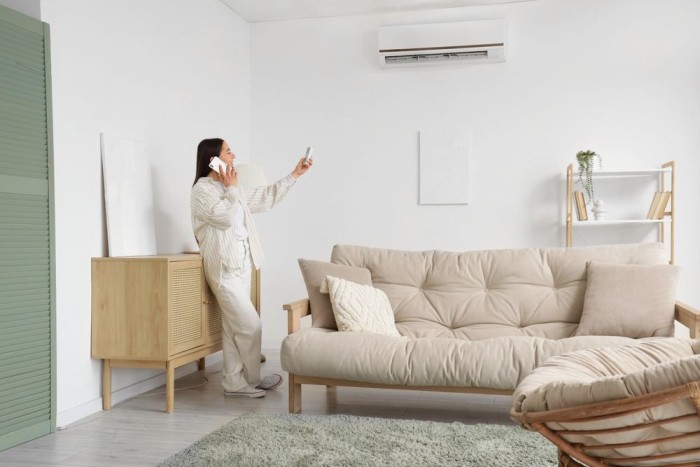
Does your home get too hot in summer and freezing in winter? If your energy bills spike with every season, you’re not alone. In Victoria, heating and cooling can account for over 50% of a household’s energy use, according to Energy Victoria. That’s why choosing the right air conditioning system isn’t just about comfort — it’s also about saving money.
So, what’s more cost-effective: a ducted reverse cycle system that cools the whole home, or a split system that targets individual rooms?
If you’re building, renovating, or simply reassessing your current system, this blog will help you weigh up the energy savings, running costs, and long-term efficiency of each option.
Quick Recap: What’s the Difference Between Ducted and Split Systems?
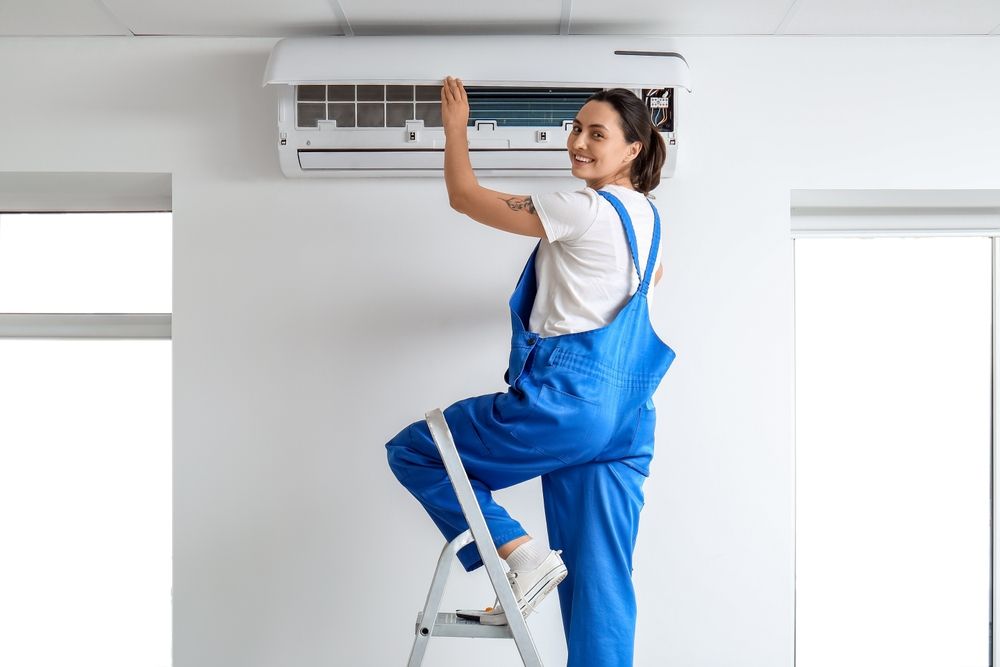
Split System Air Conditioning
Also called a split AC or a split system AC, split systems are made up of an indoor and outdoor unit that work together to remove and release air.
With this, you can cool individual rooms by installing more than one unit around your home, connecting to one outdoor unit with a condenser and compressor. This regulates the temperature of outdoor air before it is brought indoors.
The indoor system is typically mounted onto the wall, blowing warm or cool air into your room. Both units are connected by insulated tubes, which are piped through a small hole in the wall.
Split systems don’t require a big investment upfront; you’re not purchasing an entire system of ductworks and vents, so minimal modifications are needed for your property.
They are typically more flexible than ducted AC, can be installed in rooms of your choice, and additional units added at any time.
If you prefer the idea of purchasing more than one unit, Daikin Lite systems are excellent options.
That said, the heating and cooling capacity has its limits, and it might not work well for your spaces. Although they are cheaper, costs add up if you require multiple units.
External condenser units aren’t a pretty sight for some. Unlike ducted, split system indoor and outdoor units are bulky, and you might not like how they look on your walls.
The internal unit can only push air so far, so a split system struggles with larger rooms or areas with interior walls.
Ducted Reverse Cycle Air Conditioning
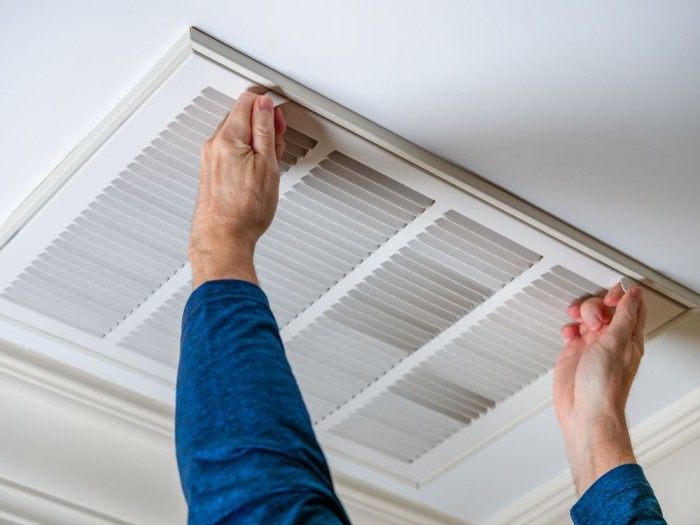
Ducted air conditioning is different from a split system as it works centrally, heating and cooling the air using one unit. The air is then distributed through vents and ducts allocated around your home.
Some ducted air conditioners–like Daikin models–have zoning features, allowing you to adjust the temperature in each room separately as opposed to a “whole home”. Switch off the heating in specific rooms when you’re not using them.
Controlled by a thermostat, ducted heating is good at keeping a constant temperature throughout your property, and you can also increase or decrease the airflow with an air volume controller.
Ducted air conditioning systems have their limitations. It is generally more expensive to purchase and install since it is installed on your roof, and technicians spend more time cutting into your ceiling. You may be up for higher energy costs, so keep this in mind (it also depends on the Energy Star Rating of the system).
It is recommended to have a ducted system installed during the building or renovation process of your home. Ducted reverse cycle heating and cooling options can be easily concealed.
For example, apartments with not much roof space or double-storey properties require extra thought and planning. And if you spend more time in only a small area of your home, it can be wiser to buy a split system.
With this in mind, it is quieter than a split system AC and can be tucked behind walls to be more discreet, is better at maintaining temperature throughout the seasons, and maintains an even temperature throughout the home.
It services the whole property, and each room can have different settings if the AC is zoned.
Still unsure? Read: Single vs Multi-Split Systems: Which One is Better For You?
What do you need to consider before buying?
- Know your home. Are there any draughts, such as gaps around windows, doors, or vents? Are your walls and floors correctly insulated? Seal these gaps. Heat is lost through walls, floors and ceilings during winter.
- How is your home constructed? The materials (such as brick or weatherboard) can impact your heating and cooling.
- What are your local climate conditions? In Victoria, look for a unit with a higher energy efficiency rating. You can also speak to an installer about models and sizes.
- How much sun or shade does your property get? The direction your house faces impacts natural heat gain, which lowers your heating load during the day.
- Know the size of your room, such as width, length, and ceiling height. Ceilings higher than the room standard of 2.4m require more energy to heat or cool.
Let’s Talk Numbers: How Much Do These Systems Cost to Run?
Energy costs vary depending on how big your space is, how often you use your system, and how efficient it is. Here’s a breakdown based on Energy Victoria’s 2024 data:
Split system annual running costs based on 5-6 star-rated units
| Room Size | Annual Energy Cost | Greenhouse Gas Emissions |
| Small room (12m²) | $6 | 0.1 tonnes |
| Medium room (30m²) | $17 | 0.3 tonnes |
| Large room (60m²) | $33 | 0.6 tonnes |
Ducted system annual running costs based on 3-3.5-star rated systems
| Home Size | Multi-Split Cost | Ducted System Cost (non-zoned) | GHG Emissions |
| Small home (100m²) | $57 | $71 | 1.3 tonnes |
| Medium home (160m²) | $90 | $125 | 2.3 tonnes |
| Large home (220m²) | $125 | $172 | 3.2 tonnes |
Zoned ducted systems are typically more efficient than non-zoned ones, but only if you use the zoning properly (such as shutting off unused rooms).
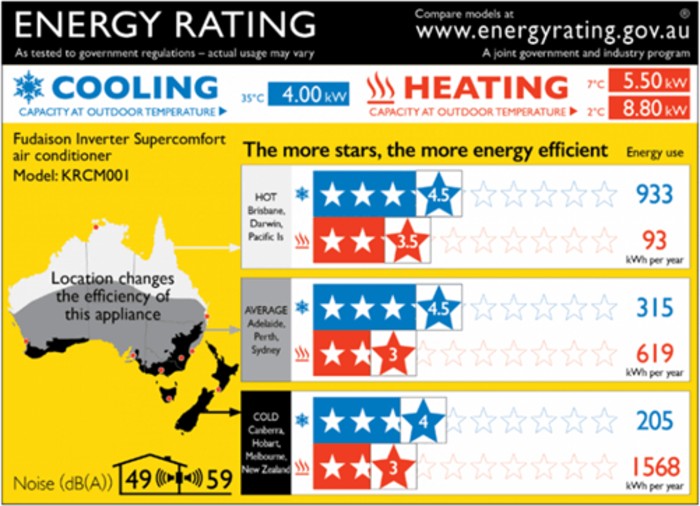
Reverse cycle ACs display a zoned energy rating label which provides energy consumption information of the product based on the climate it’s installed in. The more stars the product has, the less energy it will use. Check out the Energy Rating Website by the Australian government.
How do you decide on a size?
The size is a reference to its rated heating and cooling capacity output, such as in kilowatts (kW). A reverse cycle air con has both a heating and a cooling cycle.
- If the system is too small, it won’t heat/cool your area on hot or cold days and will take longer to bring the room to the right temperature.
- If the system is too big, it will cost more to buy, run, and be less efficient than tinier systems. And if it’s oversized, it can result in temperature swings.
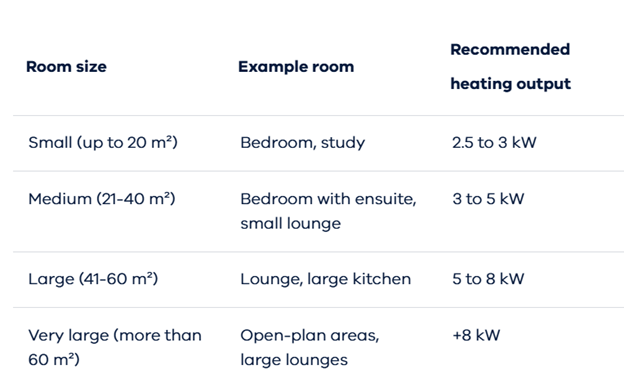
Recommended size for single-split or multi-split air conditioning
Your installer will conduct an on-site assessment and calculation, and there are also online calculators to assist with this estimation, like the FairAir Calculator, developed by the Australian Institute of Refrigeration, Air Conditioning and Heating. Energy Victoria recommends providing 1.1 to 1.4kW of heating output for every 10m² of your home covered by a ducted system.
Energy Victoria states you should speak to your installer to ensure your ducting is appropriately insulated and correctly sized for your heating and cooling load. Ducts can lose heat if they are not well sealed and insulated, so well-designed ducting will make your system more efficient to run.
If you are planning to install a ducted reverse cycle air conditioner, your existing ducting may need to be upgraded.
For households looking to upgrade to reverse cycle air conditioning in Victoria, the Victorian Energy Upgrades (VEU) program offers you incentives to make this transition. Systems offered under the VEU program include single-split systems, multi-split systems, and ducted systems. Visit heating and cooling for households to learn more.
Ask TTV Heating and Cooling if you qualify for the program.
Which System is More Cost-Efficient for Your Home?
Choose Split Systems if:
- You only need one or two rooms cooled/heated (e.g. bedroom and lounge).
- You’re in a small home or apartment.
- You’re not home much during the day.
- You want lower upfront installation costs.
- You’re prioritising room-by-room control and minimal running time.
Choose Ducted Air Conditioning if:
- You have a larger family, and multiple rooms are used regularly.
- You’re building or renovating (easier to install ducting).
You want a discreet design with vents instead of wall units. - You’ll use zoning to limit airflow to rooms you’re actually using.
- You’re seeking even temperature across the home, all year round.
Besides the unit, what affects the energy efficiency? Insulation (draughts, leaking windows, or poor ceiling insulation), system size (which wastes energy), sunlight/shade, ceiling height, or thermostat use.
TTV Heating and Cooling: How We Help You Decide
When looking for an energy-efficient option, should you go for split systems or ducted reverse cycle air conditioning? From general maintenance to scheduled servicing, multi-head split systems, or commercial heating and cooling, TTV can help you pick the best option!
- We have over 60 years of combined expertise and are a family-owned business.
- We’re service agents for Daikin, Mitsubishi Electric and Haier.
- We’re a preferred provider to Austin Hospital.
- Our sales, installations, servicing, and repairs are all done in-house.
- We’re Mitsubishi Electric Diamond Dealers and a preferred Daikin Dealer.
- We don’t use any subcontractors.
- Industries we serve include schools, offices, businesses, childcare centres, nursing homes, and more.
- We’re fully insured and accredited.
Whether you’re keen on ducted heating in Kew, Balwyn, Burwood, Box Hill, Eltham, Doncaster, or split systems for your Donvale, Camberwell, Malvern, Hawthorn, Ivanhoe, or Bulleen property, request a free quote from TTV for sales, installation, or service guidance.
Need Heating and Cooling for Your Melbourne Property? Enquire Now!
Proudly serving since 1962, TTV Heating & Cooling have provided great customer service and top quality products to Australian families and businesses for decades.
Covering lighting, heating and cooling, and everything else electrical, our technicians can ensure that your home is comfortable, responsive, and able to meet the needs and requirements of the space.
Continuing to grow with the developments in energy-efficient heating and cooling solutions and technologies over the years. We help you take advantage of what new technology has to offer.
Contact us by calling 03 9852 2335 or emailing mail@temptv.com.au.
